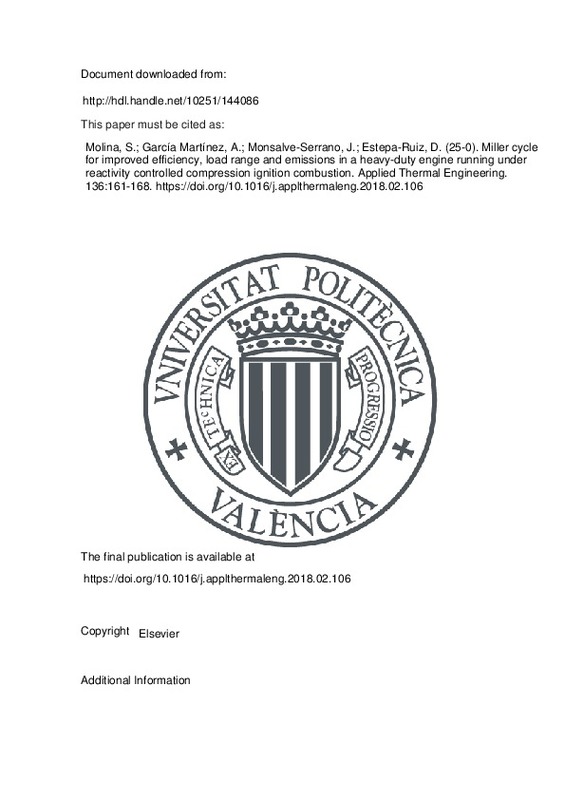JavaScript is disabled for your browser. Some features of this site may not work without it.
Buscar en RiuNet
Listar
Mi cuenta
Estadísticas
Ayuda RiuNet
Admin. UPV
Miller cycle for improved efficiency, load range and emissions in a heavy-duty engine running under reactivity controlled compression ignition combustion
Mostrar el registro sencillo del ítem
Ficheros en el ítem
| dc.contributor.author | Molina, Santiago
|
es_ES |
| dc.contributor.author | García Martínez, Antonio
|
es_ES |
| dc.contributor.author | Monsalve-Serrano, Javier
|
es_ES |
| dc.contributor.author | Estepa-Ruiz, Daniel
|
es_ES |
| dc.date.accessioned | 2020-05-22T03:02:32Z | |
| dc.date.available | 2020-05-22T03:02:32Z | |
| dc.date.issued | 2018-05-25 | es_ES |
| dc.identifier.issn | 1359-4311 | es_ES |
| dc.identifier.uri | http://hdl.handle.net/10251/144086 | |
| dc.description.abstract | [EN] The low temperature, premixed combustion strategies are being investigated in the recent years as a mean to break the NOx-soot trade-off appearing during the diffusive conventional diesel combustion. This approach relies on promoting premixed combustion events with shortened duration, which reduces the heat transfer losses, improves the thermal efficiency, and allows a simultaneous reduction of engine-out NOx and soot emissions. However, since the combustion onset only depends on chemical kinetics, most of these strategies cannot be implemented at medium and high loads due to excessive pressure gradients, which lead to unacceptable noise levels and reliability issues. This experimental work investigates the potential of the Miller cycle as a strategy to minimize the aforementioned challenges when operating under reactivity controlled compression ignition combustion. Moreover, the coupled effect of the Miller cycle with the fuel reactivity modulation is also explored as a way for improving the combustion control. For this purpose, parametric studies varying the effective compression ratio and gasoline fraction have been done in a single-cylinder heavy-duty engine operating at 14 bar indicated mean effective pressure and 1200 rev/min as a baseline condition. The results show that this strategy allows better control of the in-cylinder thermodynamic conditions, enabling a simultaneous reduction of nitrogen oxides and soot emissions down to the EURO VI limits, while keeping a reduced fuel consumption and suitable in-cylinder maximum pressure gradients. | es_ES |
| dc.description.sponsorship | The authors thanks VOLVO Group Trucks Technology for supporting this research. The authors also acknowledge the Spanish economy and competitiveness ministry for partially supporting this research (HiReCo TRA2014-58870-R). Daniel Estepa is partially supported through contract FPI-S2-2015-1091 of Programa de Apoyo para la Investigacion y Desarrollo (PAID) of Universitat Politecnica de Valencia. | es_ES |
| dc.language | Inglés | es_ES |
| dc.publisher | Elsevier | es_ES |
| dc.relation.ispartof | Applied Thermal Engineering | es_ES |
| dc.rights | Reconocimiento - No comercial - Sin obra derivada (by-nc-nd) | es_ES |
| dc.subject | Reactivity controlled compression ignition | es_ES |
| dc.subject | Miller cycle | es_ES |
| dc.subject | Emissions control | es_ES |
| dc.subject | Engine efficiency | es_ES |
| dc.subject.classification | MAQUINAS Y MOTORES TERMICOS | es_ES |
| dc.title | Miller cycle for improved efficiency, load range and emissions in a heavy-duty engine running under reactivity controlled compression ignition combustion | es_ES |
| dc.type | Artículo | es_ES |
| dc.identifier.doi | 10.1016/j.applthermaleng.2018.02.106 | es_ES |
| dc.relation.projectID | info:eu-repo/grantAgreement/UPV//FPI-S2-2015-1091/ | es_ES |
| dc.relation.projectID | info:eu-repo/grantAgreement/MINECO//TRA2014-58870-R/ES/REDUCCION DE LAS EMISIONES DE CO2 EN VEHICULOS PARA TRANSPORTE USANDO COMBUSTION DUAL NATURAL GAS-DIESEL/ | es_ES |
| dc.rights.accessRights | Abierto | es_ES |
| dc.contributor.affiliation | Universitat Politècnica de València. Departamento de Máquinas y Motores Térmicos - Departament de Màquines i Motors Tèrmics | es_ES |
| dc.description.bibliographicCitation | Molina, S.; García Martínez, A.; Monsalve-Serrano, J.; Estepa-Ruiz, D. (2018). Miller cycle for improved efficiency, load range and emissions in a heavy-duty engine running under reactivity controlled compression ignition combustion. Applied Thermal Engineering. 136:161-168. https://doi.org/10.1016/j.applthermaleng.2018.02.106 | es_ES |
| dc.description.accrualMethod | S | es_ES |
| dc.relation.publisherversion | https://doi.org/10.1016/j.applthermaleng.2018.02.106 | es_ES |
| dc.description.upvformatpinicio | 161 | es_ES |
| dc.description.upvformatpfin | 168 | es_ES |
| dc.type.version | info:eu-repo/semantics/publishedVersion | es_ES |
| dc.description.volume | 136 | es_ES |
| dc.relation.pasarela | S\354783 | es_ES |
| dc.contributor.funder | Volvo Group Trucks Technology | es_ES |
| dc.contributor.funder | Universitat Politècnica de València | es_ES |
| dc.contributor.funder | Ministerio de Economía, Industria y Competitividad | es_ES |







![[Cerrado]](/themes/UPV/images/candado.png)

